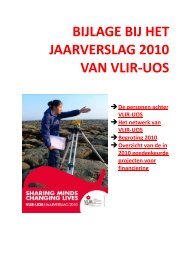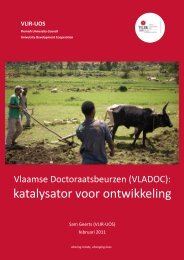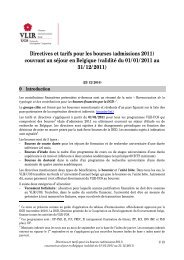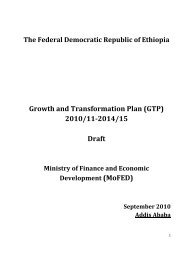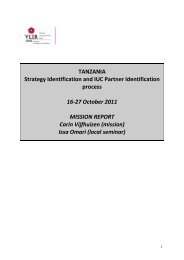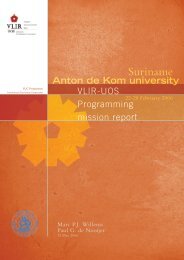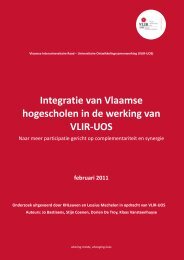Education Sector Development Program - VLIR-UOS
Education Sector Development Program - VLIR-UOS
Education Sector Development Program - VLIR-UOS
Create successful ePaper yourself
Turn your PDF publications into a flip-book with our unique Google optimized e-Paper software.
<strong>Education</strong> <strong>Sector</strong> <strong>Development</strong> <strong>Program</strong> IV<br />
• Labor market information system<br />
to assess labor market demand is<br />
inadequate<br />
• The system for information<br />
sharing and coordination between<br />
the regions and the federal level is<br />
weak<br />
• There is a shortage of teaching<br />
materials especially in newly<br />
developed OS<br />
• Utilization of resources and<br />
equipment is inefficient<br />
• TVET institutions are not always<br />
adequately equipped<br />
• There is low capacity to assess and<br />
certify TVET candidates<br />
2. Expected program outcomes<br />
❚<br />
❚<br />
❚<br />
❚<br />
❚<br />
❚<br />
❚<br />
❚<br />
TVET providers and institutions<br />
strengthened to be centers for<br />
technology capabilities’ accumulation<br />
and transfer<br />
TVET institutions capable of providing<br />
support to the incubation and<br />
establishment of MSEs as well as<br />
upgrading and strengthening existing<br />
MSEs<br />
Quality of TVET (formal and nonformal)<br />
improved at all levels and<br />
made responsive to the needs of the<br />
labor market<br />
A comprehensive, integrated, outcome<br />
based and decentralized TVET system<br />
for Ethiopia established<br />
Relevant TVET offers which are crucial<br />
to national development expanded<br />
Institutional set-up to manage<br />
the TVET reform and deliver TVET<br />
programs reinforced<br />
A sustainable financing system for<br />
TVET with efficient and cost-effective<br />
delivery systems and management<br />
structures developed<br />
Equal access of females and rural<br />
communities and people with<br />
special needs to TVET ensured and<br />
empowered<br />
Key outcome targets<br />
TVET enrolments will increase from 717,603 to<br />
1,127,330 in 2014/15<br />
Number of TVET trainers will increase from<br />
14,596 in 2009/10 to 22,547 in 2014/15<br />
Number of TVET institutions will increase from<br />
814 in 2009/10 to 1,127 in 2014/15<br />
Number of Polytechnics will increase from 1 in<br />
2009/10 to 53 in 2014/15<br />
Number of trained technology adopters will be<br />
3,000 in 2014/15<br />
Number of transferred technologies will be<br />
1,000 in 2014/15<br />
• Copied/imitated 950 in 2014/15<br />
• Improved 50 in 2014/15<br />
Number of incubated MSEs for technology<br />
transfer will increase from 600 to 3,000 in<br />
2014/15<br />
• 2,670 micro-enterprises with capital<br />
acquired up to 20,000 ETB<br />
• 300 small scale enterprises from 20,000 to<br />
500,000 ETB<br />
• 30 medium size entreprises above 500,000<br />
ETB<br />
Number of occupations with occupational<br />
standards increases from 250 in 2009/10 to 390<br />
in 2014/15<br />
Number of occupations with assessment tools<br />
will increase from 211 in 2009/10 to 390 in<br />
2014/15<br />
Number of accredited assessment centers will<br />
increase from 174 in 2009/10 to 500 in 2014/15<br />
Share of competent/certified candidates will<br />
increase from23% in 2009/10 to 60% in 2014/15<br />
Number of accredited assessors will increase<br />
from 1,860 in 2009/10 to 5,000 in 2014/15<br />
Number of enterprises involved in cooperative<br />
training will increase from 1,208 in 2009/10 to<br />
30,062 in 2014/15<br />
Share of trainees accommodated by cooperative<br />
training will increase from 163,509 in 2009/10 to<br />
901,864 in 2014/15.<br />
Number of enterprises conducting in-company<br />
training will increase from 15 in 2009/10 to 295<br />
in 2014/15<br />
Share of TVET managers at national, regional<br />
and institutional level trained in modern<br />
management techniques will be 100%<br />
Share of enrolments of females will increase<br />
from 46% in 2008/2009 to 50% in 2014/15<br />
Number of institutions in rural areas will<br />
increase by 100% in 2014/15<br />
Share of enrolments of students with special<br />
needs will increase by 100% in 2014/15<br />
3. Policy and strategies<br />
As mentioned earlier, the TVET strategy of<br />
2008/2009 will guide the content of components<br />
and activities to be deployed under ESDP IV together<br />
with new orientations, such as to strengthen the<br />
role of the TVET sector in technology capabilities<br />
55





